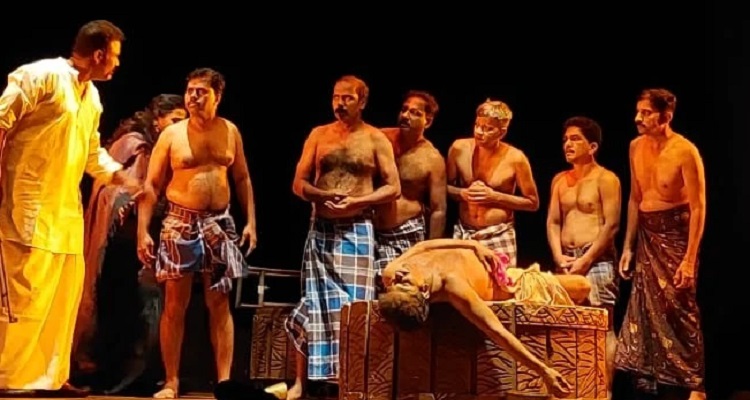Bhaskara Pattelarum Thommiyude Jeevithavum
The play opened in media res with an assiduously choreographed murder. While the stage was being set with sinister background music and intense red lighting that prophesied peril, the audience sat transfixed as the mundu-clad perpetrator took off the mask revealing his identity and there we had on stage, our archetypal villain- Bhaskara Pattelar!
Suveeran’s Bhaskara Pattelarum Thommiyude Jeevithavum is a play based on the novelette by famous Malayalam writer Paul Zacharia. Showcased as a part of the 17th Mahindra Excellence in Theatre Awards at Kamani Auditorium, the play depicted the trajectory of Thommi- a Christian migrant labourer from Kerala- who was the obedient slave of his tyrannical landlord, Bhaskara Pattelar. As was evident from the very first scene, Pattelar is a man of many vices and Thommi, during the course of the play, becomes not only a witness to his sinful life but its sole custodian. Eventually, Pattelar gets killed by his adversaries. While this tragic event is expected to violently shake Thommi’s emotional makeup, it ends up setting him free!
As the light directed the audience’s gaze to the centre stage, the first thing that captured my attention was the pedestal where Pattelar sat with an unmistakable air of superiority. The gambling, rapes, inebriation and abuse surrounding this circular pedestal created the illusion of the world revolving around Pattelar from which there was no escape. Skilfully capturing the pathos of the proletariat, the brutal strangulation that opened the first scene remained a defining characteristic of the drama as Patellar maintained his stronghold on the lives of those around him, especially Thommi.
The bustling background music and the infectious energy of the actors had a rather hypnotising effect on the audience. The play beautifully portrayed the seduction of power by contrasting it with the shame and nakedness of poverty through elaborate rhythmic movements and a remarkable chemistry created on stage. In fact, it would be a disservice not to mention the spectacular job done by Omana (Thommi’s wife), who embodies in her graceful oeuvre the palpable hierarchies of gender and class. In one particularly moving dream sequence, Saroja (Pattelar’s wife) and Omana embraced each other with their flowing swan-white silhouettes fusing into one which I interpreted as a delicate yet impactful critique of gendered oppression.
Navigating through the heightened internal and external conflicts of the play, the audience members were repeatedly made to refer to their moral compasses in order to ration out their due sympathies. Thommi’s deep-seated need for self-actualization through his relationship with Patellar, Pattelar’s avarice, the uncertain nature of Omana’s relationship with Pattelar and Saroja’s cold-blooded murder, all created a multilayered narrative of oppression. By deconstructing the master-slave hyphenation and parading the naked truth on stage, the play gently tapped on the fourth-wall, raising simple question with complicated answers.
One of the truly pivotal moments in the play was Patellar calling Thommi by his name instead of a derogatory slur. That, for me, was the precise moment when both, Pattelar and Thommi reclaimed their humanity in the most fundamental form. As the plot thickened, the characters showcased great psychological depth and explored a commendable emotional range that was untapped in the first half. The audience got a glimpse into Thommi’s dreams that opened a chasm between the socio-political plight of his servitude and his innate desire for freedom. There’s an element of impending threat, generous dollops of melodrama, emotional turbulence, dilemma and an intangible ray of hope- the key ingredients that made this production “better than some of the other versions of this text”- Shashi Tharoor.
As I was sitting in the dark auditorium getting deeply sucked into the drama of a Malayalam play coming to life through English subtitles, I had to appreciate the stagecraft that beautifully manipulated the atmosphere, best mirroring the dramatic tension through changing lights, complementary and contrasting music, intuitive choreography and elaborate props. The overall theatrical spectacle made sure that none of the cultural nuances and intricacies of language and diction were lost in translation. But as I left the proscenium, I realised the juxtaposition of the real world with the 80 minutes I saw on stage was not that striking- the stage was only a microcosm of the real world!
The story was not new, neither were the characters. You and I have seen the same story unfold several times with a different cast of actors onstage and offstage in a setting more familiar than this as well as less and yet the grip the cumulative drama had on the audience is testimony to its masterful direction and execution that definitely deserves to be watched. After all, isn’t it the greatest responsibility of art to hold a mirror to society in its rawest form?




Leave a reply